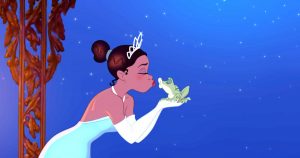While constructing these gender roles, Disney simultaneously creates an exclusive audience through their underrepresentation and/or misrepresentation of race in their Princess movies. The audience of Disney Princess movies quickly identify with these fictional characters, picking their favorite figure and striving to be like them, but only if they can relate with them first. If you were a child of color growing up with the release of these movies, relating to one of the Princesses was much harder because of the appearance differences. Since most of the Disney princesses were white, ethnic watchers struggled to look up to them because they did not identify with them. Self-esteem was tested as they rarely saw princesses of color; the absence of such princesses seemed to imply that, if Disney does not think they are important enough to be represented on film, then they must not be relevant. When Mulan and Princess and the Frog were released, Disney received condemnation for their development of non-white Princesses – but they also received great criticism. Mulan adopted more assertive traits as she took on a role of a soldier, but she is only performing heroic acts as she acting as a boy. When she returns to a girl, she resumes her prescribed gender roles – quiet, domestic and reserved. In addition to reinforcing the idea that a happy ending consists of a domestic, married woman, Disney chose a story for their first Asian Princess that takes place in China and does not interact with white characters thus “no potential for Mulan to challenge the view of Asian Americans in the US as perpetual foreigners and “unassimilable” (Dundes).

In the picture above, Mulan is going against the stereotype of the Disney Princess and is fighting for herself. This is a great lesson for little girls, but unfortunately Mulan falls into the female social norms by the end of the movie. http://schmoesknow.com/disney-hires-director-executive-producer-mulan/48107/
Following Disney’s release of Princess and the Frog – which included the first black Disney Princess, the corporation received a lot of mixed reviews. There were constant reminders of Tiana’s low-class status in addition to her being non-human for most of the movie. Instead of shaping this character as equal to the other Princesses, they encouraged the idea that the first black Princess must be different. Like Mulan, Tiana is not herself for most of the movie, rather, she becomes a frog. Putting animalistic traits to the first black Disney Princess sends troublesome messages to the viewers. She is different, non-human and lacks the typical Princess traits. In addition, Tiana aspires to open a restaurant, mundane compared to other Princesses’ dreams, tying the black Princess identity to mundane labor work. Although there are many triumphs from the release of these movies starring Princesses of different ethnicities, Disney is nevertheless constructing a portrayal of women of color that reestablishes social norms. Mulan is surrounded by a military environment serving as a soldier, reinforcing stereotypical masculinity – not the classic thin, fragile white Princesses we have seen prior to the release of Mulan. On the other hand, Tiana is a hardworking girl who turns into a frog, and finally becomes a restaurant owner, which is inconsistent with the other princess fantasies. Disney supports stereotypical racial norms by tying her black identity with modest dreams and mundane labor. Overall, Disney takes a large step in the right direction by creating these ethnic Princesses, but the company continues to marginalize nonwhite Princesses and conserves a hierarchy based on race.

In this picture, Tiana – star of “The Princess and the Frog” – is kissing a frog which later turns her into a frog herself, putting animalistic attributes to the first black DP. http://www.pluggedin.com/movie-reviews/princessandthefrog/
Isabel Wyer